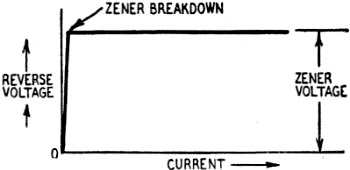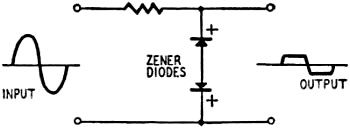The Backward Diode |
|
Not everyone who visits RF Cafe is a seasoned engineer or technician. Some are just getting into electronics as part of a career path and/or hobby endeavor and appreciate the availability of entry-level information. As an oft-quoted sage-type person famously said, "A journey of a thousand miles begins with the first step." Accordingly, here is a short article explaining the basic physics and application of the of backward diode, which is akin to a Zener diode and tunnel diode in that it is meant to operate in the reverse bias region. National Semiconductor, Texas Instruments (TI), and Raytheon were the manufacturers in 1958 when this article appeared in Radio−Electronics magazine. National Semiconductor was swallowed up by Texas instruments in 2011. Thanks for your indulgence - or you're welcome - depending on your experience level. The Backward Diode By Ed Bukstein Zener diodes have applications in voltage regulation and wave clipping Fig. 1 - Characteristic of a Zener diode when a reverse voltage is applied. Fig. 2 - Voltage drop across Zener diode remains constant even though current may vary over wide limits. Fig. 3 - Connected in opposite directions, Zener diodes clip extremes of input waveform. Most technicians have resigned themselves to the fact that the arrow-like symbol used to represent non-thermionic diodes does not point in the direction of electron flow. Now, to augment the confusion caused by this unfortunate choice of symbol, comes a new application for the silicon diode. In this application, the diode is intentionally connected with reverse polarity in a DC circuit. It is well known that a silicon diode has a low forward resistance and a high back resistance. Not so well known is that the back resistance suddenly decreases at a certain value of reverse voltage. The voltage required to produce this breakdown of back resistance is known as the Zener voltage. As shown by the characteristic curve in Fig. 1, the current is practically zero for all values of reverse voltage up to the Zener value. When the Zener breakdown occurs, the reverse current suddenly increases. As the characteristic curve shows, in this region the voltage across the diode is nearly independent of the current flow through it. This ability of the diode to maintain a constant voltage makes it useful in voltage reference and regulating circuits. Fig. 2 shows how the Zener diode is connected to maintain a constant voltage across a load. Although current flow through the diode may vary, due to line voltage or load changes, the voltage across the diode remains constant. The Zener diode offers many advantages over other voltage regulating elements such as gas-filled tubes. It is smaller, lighter, mechanically rugged and has a long life. The Zener diode can be manufactured for any value of regulated voltage from a few volts to several hundred and for operating currents from a few milliamperes to over an ampere. In general, it is better to use several low-voltage diodes connected in series rather than a single diode of higher Zener voltage. The advantage of the series arrangement is that the total power dissipation is divided among several diodes. For this reason, temperature change in each diode is relatively small and stability is improved. Fig. 3 illustrates the possibility of using two Zener diodes in a squaring or clipping circuit. The two diodes are connected in opposing directions so that they break down on opposite alternations and prevent the output from rising above the Zener value. The Zener diode is a relatively recent development and many other uses for it will be forthcoming. Numerous Zener (voltage-reference) silicon diodes are made by National Semiconductor Products, Raytheon, Texas Instruments and other manufacturers of semiconductor products and sold through distributors and mail-order radio and electronic parts supply houses. Among the silicon diodes listed specifically for voltage-regulator and reference applications are the Raytheon 1N437 and 1N438, and Texas Instruments 650C-653C and 650C0-653C9. - Editor
Posted July 16, 2020 |
|



